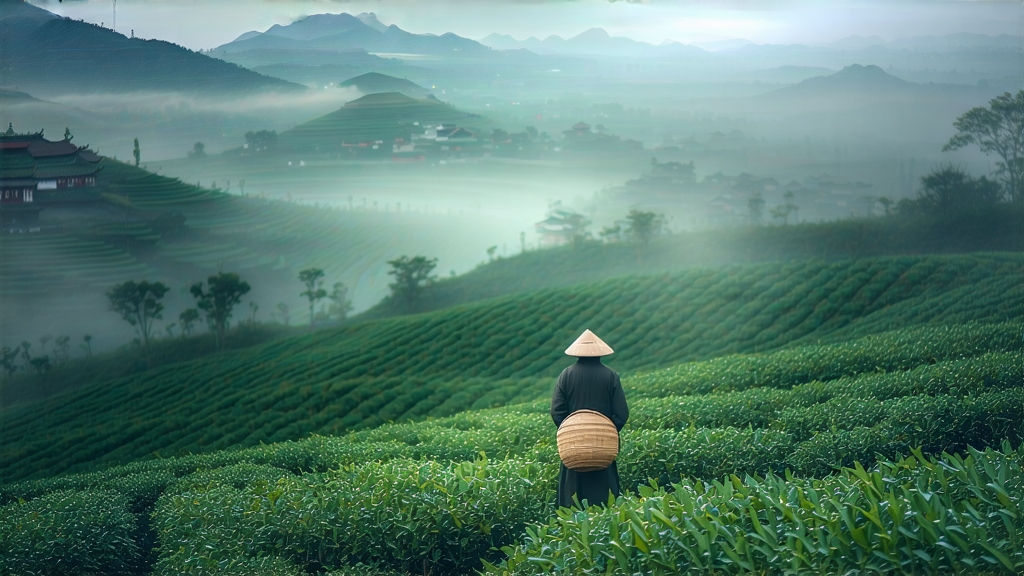
Biluochun, whose name translates literally to “Green Snail Spring,” is one of China’s ten most celebrated teas, yet it remains curiously under-celebrated outside specialist circles. Produced exclusively from the tiny, lake-locked Dongting Mountain range in Jiangsu Province, this tea carries within its tightly rolled spirals more than a thousand years of imperial praise, maritime trade lore, and meticulous hand-craft. To understand Biluochun is to witness how Chinese green tea can express both explosive aromatics and feather-soft texture without ever leaving the realm of minimal oxidation.
1. Historical vignette: from scare to scarlet seal
Local chronicles first mention a tea called “Xia Sha Ren Xiang” (literally “Scary Fragrance”) during the late Tang dynasty, so intensely aromatic that tea pickers feared it was haunted. Legend credits a young tea picker who hid fresh leaves in her bosom, where body heat created an unexpected enzymatic blush and a fragrance that drifted across Taihu Lake. By the Song dynasty the tea had become a tribute item; the Kangxi Emperor, visiting the region in 1699, rechristened it Biluochun after its snail-shell shape and spring harvest. The imperial red seal elevated it above Longjing in certain court years, securing state-sponsored transport via the Grand Canal to Beijing.
2. Terroir: an island within a lake within a plain
Dongting Mountain is actually two peaks—Dongshan (East) and Xishan (West)—rising out of China’s third-largest freshwater lake, Taihu. The lake’s moderating effect creates a mist blanket on 240 foggy days each year, filtering sunlight into soft, diffuse photons ideal for the slow accumulation of amino acids, especially L-theanine. Soils are acidic quartz sandstone mixed with lake-deposited humus, lending a natural pH of 4.5–5.5. Unlike the continental climate of Zhejiang’s Longjing hills, here the maritime influence keeps winter temperatures just high enough for the earliest spring budding in China, often before Qingming (early April).
3. Cultivar lineage: two bushes and their babies
The original population consists of seed-propagated “Dongting Qunti” (group-type) bushes, a mixed gene pool with tiny leaves and purple petioles. In the 1980s researchers selected two superior clones:
- Fuding Dabaicha grafted for higher yield, prized for white down and rapid early sprouting.
- Dongting #7, a local dwarf variant with anthocyanin-rich young leaves that turn jade-green after firing.
Modern gardens intercrop these with loquat, plum, and bayberry trees; the fruit blossoms coincide with tea flush, adding a subtle floral substrate absorbed by the tea’s trichomes.
4. Harvest calendar: one bud, one standard
Authentic Biluochun is plucked at the “single bud with half-open leaf” stage, when the apical bud is 1.5–2 cm and still downy. Experienced pickers finish before 10 a.m. while dew remains; the moisture acts as a natural protective wrapper against mechanical bruising. Roughly 70,000 such shoots—about 500 g fresh—yield only 100 g finished tea.
5. Crafting the spiral: a kinetic poem in three acts
Unlike flat-pan Longjing or strip-shaped Maofeng, Biluochun’s signature curl is created by a “dual-hand pan-firing” technique recognized as national intangible heritage.
Act I: Withering on bamboo
Leaves are spread 2 cm thick on perforated bamboo trays for 60–90 minutes, allowing 15 % moisture loss and grassy volatiles to escape.
Act II: High-heat killing-green (shaqing)
A 160 °C cast-iron wok is swabbed with local pomelo peel oil to season the surface. The tea master tosses 250 g batches with both hands in a figure-eight motion, simultaneously pressing leaves against the wok wall to initiate enzyme deactivation. The temperature is then dropped to 80 °C within four minutes to prevent “cooked” notes.
Act III: Spiral rubbing and low-fire drying
While still pliable, leaves are rolled between thumb and index finger in a continuous spiral, each curl locking in microscopic air pockets that later unfurl during brewing. Three alternating cycles of 65 °C drying and